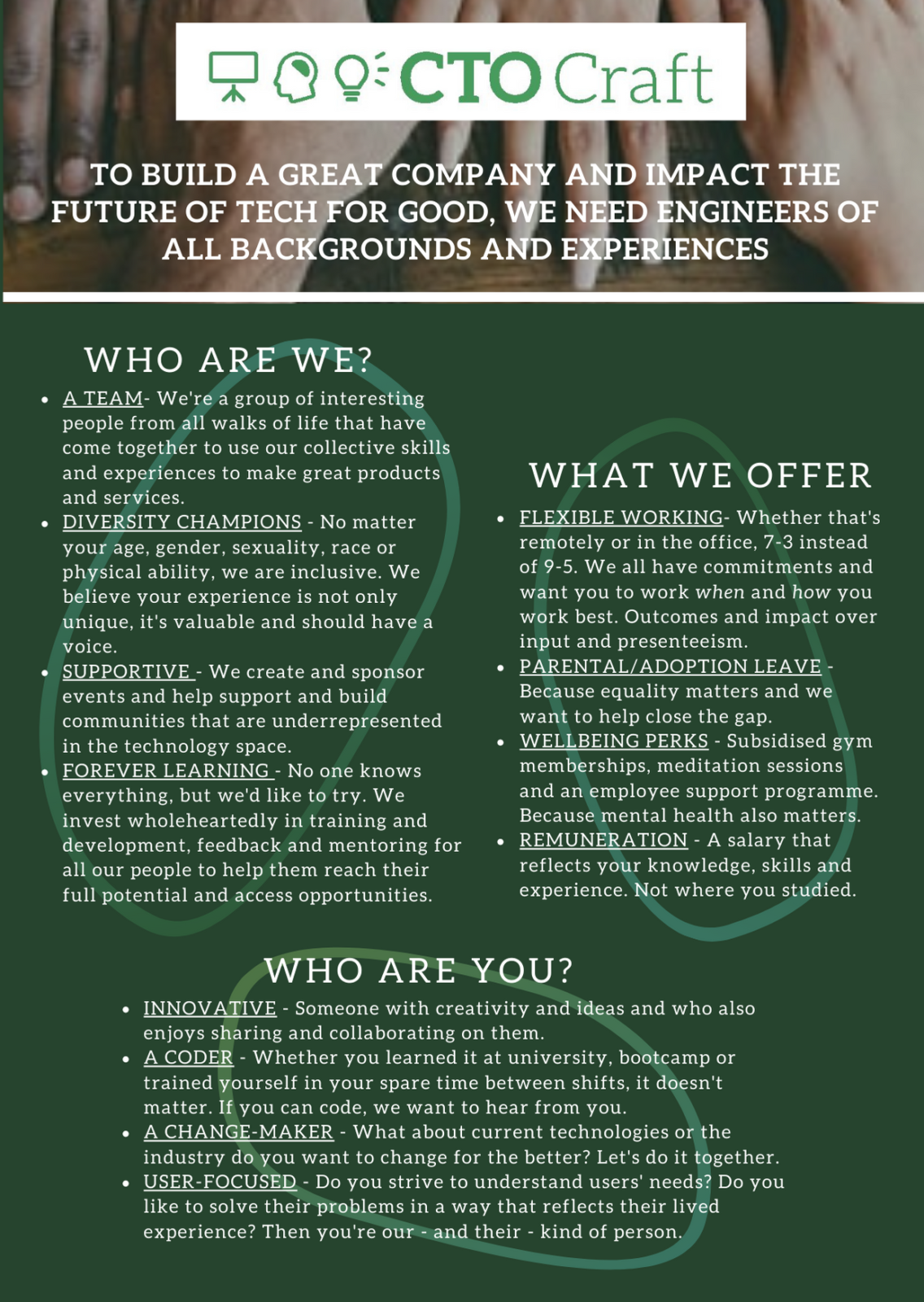People want to improve diversity and engineering in tech, but often don’t know where to start, or resist do anything at all due to worries about making mistakes, misconceptions around costs or the incorrect belief that the industry and system are okay as they are.

Behind the scenes, there are several things you can do to help foster an inclusive culture, but to be a truly diverse and inclusive company, you have to ensure your hiring process is attracting a diverse pool of talent. It’s not just about casting your net far and wide or asking agencies to find you ‘diverse candidates’, the job spec also matters. Whether you create a formal document, create posts across social media platforms or list on recruitment boards, first impressions count. Especially if your organisation is a startup or less well-known.
What is wrong with many advertisements?
While a job spec covers the trifecta of organisational culture, perks and benefits, and the role and person scope, an inclusive one needs to go further and think about:
- language;
- opportunities;
- support and development;
- accessibility; and
- other specific needs.
Technology has a bad, but accurate rap for being a cis male-dominated industry. It is changing, but very slowly and in some areas/at senior levels, the amount of women in tech is actually shrinking. It is up to us, as organisations, to take affirmative action to not only prevent this drain, but rebuild and crucially, widen the pipeline.
Sarah Hale, Director of Engineering at Unity Technology believes there is often a mismatch in expectations versus reality: “It’s important to be thoughtful and considerate with the way you’re advertising the role, but it’s equally important to be truthful. Creating a ‘perfect’ inclusive job advert isn’t enough – it also needs to accurately represent the working environment… It’s disappointing when a company places a strong emphasis on how they support flexible schedules and remote working, but in reality, that flexibility only exists if you’re in a specific role or not being managed by a specific person, who prefers in-office communication and presenteeism.“
“When looking to join a new organisation, we are all trying to assess whether we belong there. If the subconscious message taken away from a job spec implies that we won’t fit, then we’re a lot less likely to apply for the role.”
Zoe Cunningham – Director at Softwire
Requiring people to be in an office built for able-bodied people and/or at times that suit those without caring or other equally important responsibilities, will be unattractive to those who need their workplace to be flexible in terms of working venue and hours. Likewise, gendered terms like ‘rockstar’, ‘genius’ and ‘ninja’ have also been bandied around to make companies look cooler, but they can be off-putting for many who don’t feel like they fit that description.
Further, requiring people to have studied at a particular institution narrows the pool of talent you can – and should – be recruiting from. People gain their experience in different ways and access to higher education isn’t always possible for those from disadvantaged backgrounds. That doesn’t mean they don’t have the skills, talent and ideas to be great innovators – they just need the opportunities and for people to take a chance on something that may not fit an outdated and reductive mould.
So, what does an ‘ideal’ job spec look like?
As Aubrey Stern, CTO, YouTuber, Speaker and Mentor says: “A job spec is your first opportunity to get someone’s attention. It also happens to be the first opportunity to lower the barriers of entry to your organisation, diversity comes in many flavours, including hiring folks from outside your industry. Make a job spec that pops, not stops.”
There are numerous tools that can help scrutinise job specs and ads to check for bias, gendered language and vague terminology including Textio and Gender Decoder, but focus on being open, transparent and willing to learn.
With this in mind, we want to help be the change we want to see. CTO Craft doesn’t do job specs, but if we did, this is what it would look like…

“These specs reflect the shared histories of hiring managers from a very specific demographic background. If you don’t share that history you are left feeling unwanted, other or not worthy. So you simply don’t apply.
Talent knows no borders, it doesn’t care about your demographic. Neither should our job specs.”
Ezechi Britton – Founder and CTO at Impact X Capital Partners LLP
The tech industry is built on innovation, new perspectives and varying experiences – job specs have to stop acting as a chokehold and start becoming the key to open to flood gates.
***
Join us for The Complete Hiring Arc – a free digital conference on 31 May.
Hosted by CTO Craft to support and benefit the technology industry, this event is FREE to attend.
Our industry-leading speakers will discuss the new fundamental requirements of successful hiring and raise overall knowledge, standards and expectations in the post-Covid world of work.
Find out more at https://conference.ctocraft.com/.
If you or your CTO / technology lead would benefit from any of the services offered by the CTO Craft community, use the Contact Us button at the top or email us here and we’ll be in touch!
Subscribe to Tech Manager Weekly for a free weekly dose of tech culture, hiring, development, process and more.
